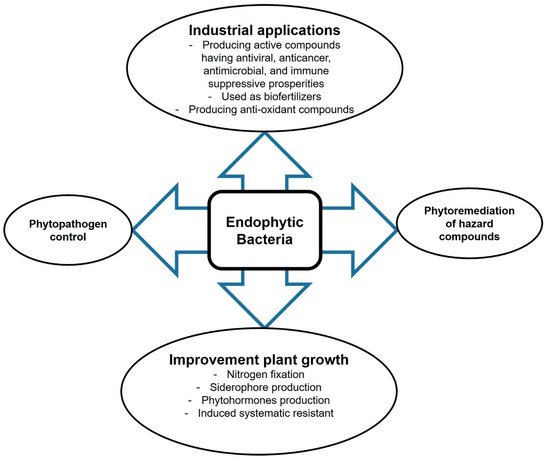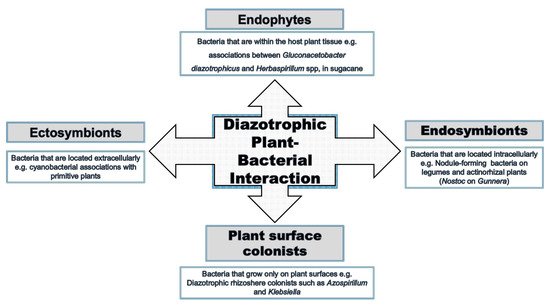Endophytes are fungal and bacterial organisms that inhabit the plant endosphere without harming their hosts.
- biotechnological applications
- endophytes
- plant growth
- biofertilizers
1. Introduction
Endophytes are fungal and bacterial organisms that inhabit the plant endosphere without harming their hosts. They live asymptomatically in the plant cellular environment and perform symbiosis-specific functions such as synthesis of secondary metabolites or signaling molecules that function as internal and external stimuli during the mutualistic interaction [1]. Endophytic microbes are sources of novel biomolecules for the biochemical and pharmaceutical industries [2]. They produce biologically active metabolites, including immune-suppressive compounds, anticancer agents, plant growth promotors, antimicrobial volatiles, insecticides, antioxidants, and antibiotics [3,4], with huge potential for application in medicine, pharmaceutics industry, or agriculture (Figure 1). Moreover, endophytic microbes can improve plant growth under harsh conditions such as nutrient stress, temperature stress, salinity, trace metal stress, or drought [5]. They can also help plants to grow in contaminated environments by degrading hazardous compounds. We describe the main concepts of the application of endophytes in agriculture and biotechnology.

2. Types of Bacterial Endophytes
3. Plant–Bacterial Endophyte Interactions
Interactions between bacteria and plants occur in many ways and at different levels (Figure 2). All plant organs interact with microorganisms at a specific stage of their life, and these interactions are not necessarily harmful to the plant. Plants can also benefit directly or indirectly from the interaction [37,38]. An example includes the well-studied rhizobia–legume interaction. Many endophytic bacteria form less specific symbiotic interactions with plants, although both partners adjust their metabolisms to the symbiotic conditions and can influence the biochemical properties of the partner [39]. This can result in promotion of the growth of the plant under normal and particularly harsh conditions [40,41].

Plants produce root exudates to attract beneficial bacteria, whereas bacterial endophytes recognize these compounds [42]. The bacteria in the root environment move towards the roots in response to the chemical attraction of the exudates [43]. After attachment to the root surface, they can enter the root, e.g., at lateral root emergence or openings caused by wounds or mechanical wounding [43]. Several bacterial structures are involved in their attachment to the plant surface, including fimbriae, flagella, bacterial surface polysaccharides, and lipopolysaccharides. For example, in Rhizobium spp., the surface polysaccharides are modified during the transition from free-living cells to the bacteroid form through the expression of surface antigens [44].
Bacterial entrance and spread inside plant tissues require plant cell wall modification, which is achieved by the secretion of cell-wall-degrading enzymes like endoglucanases, xylanases, cellulases, and pectinases by the endophytic bacteria [45,46]. Penetration into the host can be active or passive. Active penetration is completed by proliferation and attachment tools involving pili, flagella, twitching motility, and lipopolysaccharides, whereas quorum sensing influences bacterial colonization and movement in the host plant [47]. Passive penetration occurs through cracks on root tips or root emergence zones or arising from the activities of harmful organisms [12].
Bacterial colonization often begins at the root surface. After successful entry, the bacteria can move to aerial parts by the transpiration stream and with the support of the bacterial flagella [48]. This colonization pattern begins with intracellular microbial access through root hairs [49]. Endophytes can pass through the plant cell wall and enter the root cell either directly by the secretion of plant cell-wall-degrading enzymes and passage through the plant plasma membrane or by rhizophagy. Rhizophagy is a phenomenon in which many plants get microbes from the soil into their cells and digest them as a source of essential nutrients [50,51].
However, most endophytes reside in the intercellular spaces of their hosts, i.e., in sites that are rich in carbohydrates, inorganic nutrients, and amino acids [52]. Besides root colonization, endophytic bacteria can also occupy the intercellular spaces of stems, leaves, seeds, flowers, fruits, and xylem vessels [53,54,55,56,57]. Endophytes with intracellular colonization are difficult to study because they are often non-cultivable [58].
This entry is adapted from the peer-reviewed paper 10.3390/plants10050935
